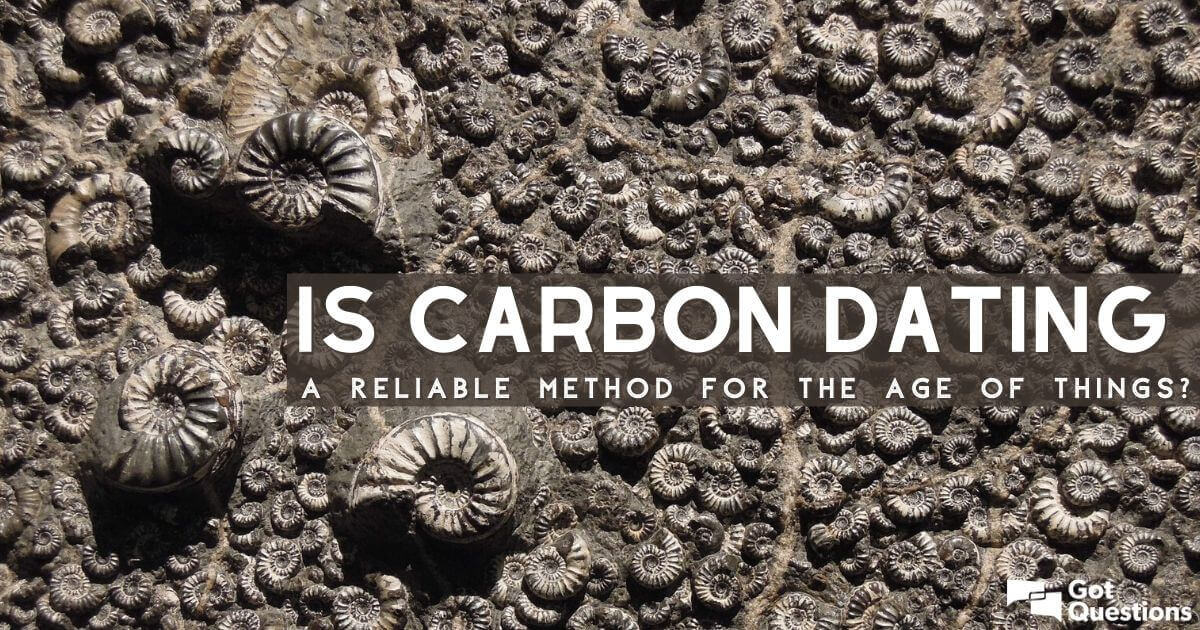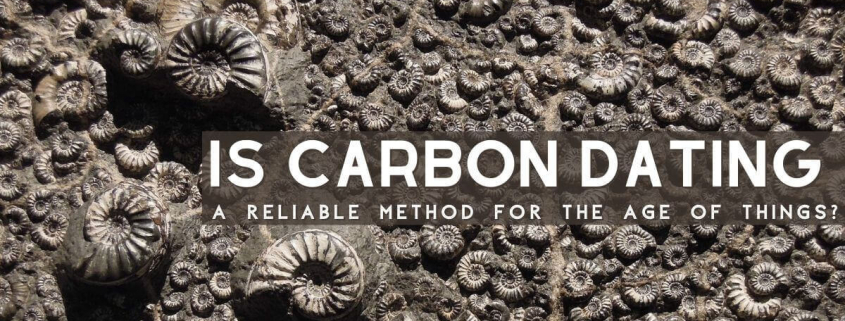Carbon 14 Dating how reliable is it?
Carbon 14 Dating how reliable is it?
Problem:
Dating methods (currently Carbon-14) are cited as definitely proving that man has been on the earth for at least 30,000 years. This age for man conflicts with Biblical chronology which dates the beginning of man’s existence on the earth about six thousand years ago.
chronology which dates the beginning of man’s existence on the earth about six thousand years ago.
Solution:
- In order to critically appraise the claim that C-14 “definitely proves” the age of man to be at least 30,000 years, a description of C-14 dating is required:
The C-14 method of dating is used to determine the age of vegetables and animal remains. The procedure rests on the fact that cosmic radiation in the upper atmosphere leads to the formation of a radioactive isotope of carbon with an atomic weight of fourteen, instead of the normal weight of twelve (C-14 instead of the normal C-12). Atmospheric carbon contains a small amount of radio-active C-14 which decays at a fixed known rate, but is continuously replaced by the formation of more C-14. The rate of breakdown is calculated in terms of the “half-life” which for carbon is 5,568 (plus or minus 30) years. After this amount of time, only half the original amount of C-14 will be left; after about 11,400 years, a quarter. Plants, by means of photosynthesis, and animals, by respiration and feeding on plants and one another, incorporate atmospheric carbon into their tissues, a process that is assumed to cease when the tissues die. As the C-14 disintegrates in the dead tissues and is not replaced, the ratio of non-radioactive carbon-12 to C-14 will slowly change, and its value at any time will depend on the time that has elapsed since the tissues died. Thus the age of the tissues can in principle be determined by comparing the ratio of non-radioactive carbon to C-14 in the tissue and in the atmosphere.1
- The C-14 dating method is only reliable if the general assumption of the uniformity of nature2 is valid. Uniformity of nature is the belief that present causes solely have operated in the past. Within this general assumption are two particular assumptions:
- That fossilized creatures when living had as much C-14 as similar things have today.3
- That the rate of decay of C-14 has remained constant (i.e., that the rate of decay has not changed in the interval from when the creatures lived to the present day).
- There are a number of technical problems involved in C-14 dating:
- It requires relatively small effects to change the level of C-14. For example the burning of coal and oil which contain virtually no C-14 has, during the past century, lowered the proportion of C-14 in the atmosphere by an amount equivalent to 400 years. The explosion of hydrogen bombs between 1955 and 1961 increased the amount of C-14 by an amount equivalent to 1500 years.
- The fossils are often contaminated by carbon from their surroundings – carbonates, humic acid, etc. Materials recovered from wet earth inevitably have been invaded by water containing carbonates, humic acid and even pitch. All these must be extracted from the sample with acid, alkali and organic solvents, and even after this some degree of contamination is possible.
- Chemical and/or biological changes may have been going on in the fossil over the centuries changing its composition. The amount of C-14 in a fossil (for example, 6,000 years old) is a very small part of the total carbon, and contamination can have a big effect. It is instructive to notice that ever since the radioactive methods of dating were introduced, almost 50 years ago, their supporters have manifested great confidence in them. Yet most of the ages determined by the uranium methods prior to 1940 and by the C-14 method prior to 1960 have been discarded because it was concluded that the methods then in use were unsatisfactory.
- Even if it be shown that there is a high degree of correlation between independent dating methods this does not in itself prove the age of man on the earth. The appearance of age may be due to the following factors:
- God’s creation was in equilibrium, hence the appearance of age.4
- Conditions have not been uniform on the earth. The record in Genesis 1:6 states that on the second day the waters were divided into two parts, water below the heaven and water above the heaven. The accumulation of water “above the heaven” would form an outer band round the atmosphere. But this does not exist today, therefore it cannot be assumed that the cosmic ray intensity has been constant. Nor can it be assumed that there has been a stable equilibrium condition between atmospheric 14CO2 (Carbon-14 dioxide) and the reservoirs, primarily the oceans. Genesis 7:12; 8:2 state that in the great Noahic flood the heavens were opened for 40 days and presumably the above-the-heaven water returned to the earth. (Vast quantities of water are now stored as ice in the frozen polar regions.) The blanket of water vapour around the earth prior to the flood would be expected to reduce the ionising power of the sun’s rays and the amount of C-14 in living things would be less than now.5 If C-14 in living things was less than it is now, then the geologists’ assumption of the uniformity of nature and hence the age postulated for fossils on the basis of these dating methods will be erroneous – the original amount of C-14 being smaller than they calculate.6
- The rate of decay of C-14 may also have been different under conditions before the Noahic flood.
Footnotes:
- See John Watts, “Carbon ‘Fourteen’ Dating”, in “The Bible and Modern Thinking – Assent or Dissent?” The Testimony, Vol. 35, No. 417 (Sept. 1965), 352-353. Return
- Lyell, sometimes referred to as “the high priest of uniformitarianism” and author of the famous textbook, Principles of Geology, wrote: ” . . . all theories are rejected which involve the assumption of sudden and violent catastrophes . . . ” Charles Lyell, Principles of Geology, 11th. ed. rev., (New York: D. Appleton and Co., 1892), 1,317-318. Uniformitarianism has been accepted in all major centers of scientific learning. Darwin built his theory of organic evolution upon the uniformitarian foundation which Lyell had laid. But the Apostle Peter denounces uniformitarianism (i.e., the belief that “all things continue as they were from the beginning of the creation” 2 Peter 3:4). He cites God’s divine intervention in the violent catastrophe of the Noahic flood (2 Peter 3:6) as evidence of its falsity. Return
- This assumption was noted at a conference of radiocarbon experts: “Throughout the conference emphasis was placed on the fact that laboratories do not measure ages, they measure sample activities. The connection between activity and age is made through a set of assumptions . . . one of the main assumptions of C-14 dating is that the atmospheric radiocarbon level has held steady over the age-range to which the method applies.” Science Digest, (Dec. 10, 1965), p. 1490. Return
- The record in Genesis presents Adam as a fully developed man when newly made. Similarly the birds, animals and plants were created full grown. This implies that the soil in which the plants were to grow was already formed. Similarly the ocean would contain the salt and other chemicals to support its marine life. In other words, there must have been an equilibrium among the innumerable and complex interrelationships between the plant and animal kingdoms, the organic and inorganic realms. This can only mean that the world when created had the appearance of age. Obviously the apparent age of the world would not be the same as the real or actual age of the world. Return
- Science Digest of Dec. 1960 reported that if the C-14 level in the atmosphere has not remained steady, ” . . . it would most certainly ruin some of our carefully developed methods of dating things from the past . . . If the level of C-14 was less in the past, due to a greater magnetic shielding from cosmic rays, then our estimates of the time that has elapsed since the life of the organism will be too long.” p. 19. Return
See G. Pearse, “The Weakness of Science Concerning the Origin of Man”, Logos, Vol. XXXII, No. 12, (Nov. 1966), 411-419. Return
See our series on HARMONY OF BIBLE AND SCIENCE
![]()



